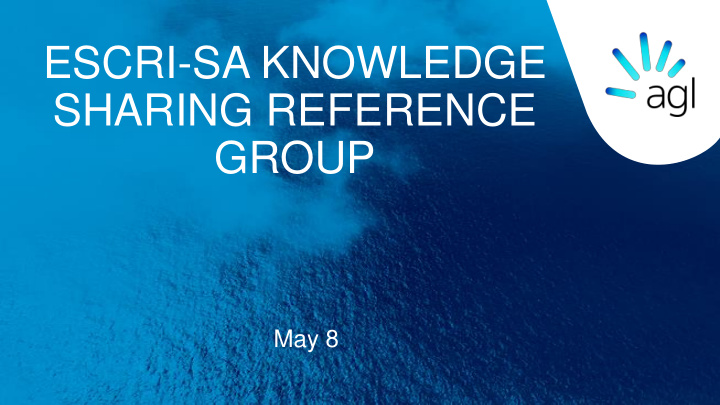



ESCRI-SA KNOWLEDGE SHARING REFERENCE GROUP May 8
1 5 ABB supplying Voltage Source Cells capability limits overload Inverters rather than Current Source capability of inverters 2 6 Effect of Cycling on Degradation - Synthetic Inertia operating fast and effectively Knowledge still developing 3 7 Batteries need resting time after a Fibre Communications to Wattle fast charge Point wind farm needed Repair 4 8 BESS has a high auxiliary load – AEMO Systems for Batteries - particularly with VSI FCAS and Re-bidding
Power System inverters such as those in solar farms are normally configured as Current Source Inverters. The ESCRI BESS has been configured to operate as a Voltage Source Inverter to enable it to manage the voltage on the York Peninsula when operating in islanded mode. The Voltage Source characteristic is hard wired in the inverter even when not operating in islanded mode. Unlike most inverter connected generators, the ESCRI battery should assist in reducing system voltage harmonics rather than contributing to them. Voltage can consume a higher auxiliary load in these high speed switching environments that Current Source Inverters 8 th May 3
Factory Acceptance tests at ABB works in Darwin have confirmed that the BESS can respond within milliseconds to provide synthetic inertia. Synthetic Inertia responds as a function of “Rate of Change of Frequency” to slow any frequency change. Once the frequency is stable, even at an abnormal frequency, the response from the synthetic inertia is zero – as it is for real inertia Typically “Fast Frequency Response” provides a set power output at specific frequencies. It will continue to provide this power even when the frequency is not changing. Future batteries may provide an amalgam of FFR and inertia 8 th May 4
Recent information from Samsung is that batteries need “Resting Time” after a fast charge. It is not yet understood how much impact any limitation on battery use after fast charging will have. A fast charge is likely to be only initiated when the battery is significantly depleted and a high wholesale price is considered likely in the near future. 5
The non-recoverable energy of the battery has several components; When the battery is operating, energy is dissipated from both the battery cells and the inverters. The cells emit most heat when charging, and the rapid temperature rise in the battery building requires large air-conditioners to cater for these bursts. The Voltage Source Inverters generate more heat than Current Source Inverters. The inverters use significant energy to be ready even when the cells are inactive. Air-conditioners at Dalrymple Nth 8 th May 6
The Samsung battery cells have no overload capability. The inverters have a 200% overload capability that can be used when providing reactive power. This capability cannot be used when providing real power. Samsung Batteries 8 th May 7
AGL have been requested to re-negotiate the agreement extend the limitation on charging and discharging. Supplier is concerned that the battery may degrade too much under the currently allowed regime. Decided to wait and gain an understanding of how the BESS is being operated and the impact on battery life over the next 12 months. Without insight into the performance of the battery AGL will be unlikely to be able to consider a AGL Head Office Diagnostic Engineers renegotiated agreement. 8 th May 8
Sections of existing fibre needed replacement Replacement fibre sections have been installed Cabling installed to isolate 80% of windfarm when islanded 8 th May 9
Gratuitous picture of Wattle Point wind farm 10
Until a separate category is created for them, batteries must be registered as both a generator and a load in the AEMO market systems. As a consequence, a battery must satisfy the specific performance standards for a generator to get registered. AEMO have recently managed to apply the rules to the ESCRI battery in a way that avoids impacting it’s ability to register the full 30MW for Frequency Control Ancillary Services without conflicting with generator registration obligations. 11
The ESCRI Battery is much more energy constrained than other dispatchable plant on the system. Even when fully charged it can only generate full output for around 20 minutes. AEMO systems are not able to fully manage the dispatching of such plant at this stage. When the battery is discharged it can no longer be bid into the AEMO dispatch engine. AGL Melbourne dispatch Centre for Hydro, Wind, AGL is developing new bidding software to provide Solar and Battery automatic rebidding, but this will not be ready at initial commissioning. A manual workaround will be used in the interim. 8 th May 12
Recommend
More recommend